She’s Electric—The Influence of Body Proportions on Perceived Gender of Robots across Cultures †
Abstract
1. Introduction
1.1. Female Robots
1.2. Anthropometrics
1.3. The Present Experiment
2. Method
2.1. Robot Body Shapes
2.2. Procedure
3. Results
3.1. Participants
- Japanese: male = 22; female = 34; total = 56; age mean = 25.17; age SD = 7.86
- Other Asians: male = 12; female = 15; total = 27; age mean = 21.93; age SD = 3.74. Specifically: Chinese = 5; Taiwanese = 2; Indonesians = 3; Myanma = 1; South Koreans = 9; Mongolian = 1; Singaporeans = 3; Vietnamese = 2; Thai = 1.
- Peruvians: male = 27; female = 27; total = 54; age mean = 27.95; age SD = 9.59
- Other Westerners: male = 11; female = 10; total = 21; age mean = 28.33; age SD = 10.01. Specifically: Spanish = 3; Argentine = 1; Uruguayan = 1; Mexican = 3; Americans = 9; Italian = 1; German = 1; Finnish = 1; French = 1.
3.2. Reliability
3.3. Gender in Language Use
3.4. Stereotypical Attributes
3.5. Correlations
4. Discussion
4.1. Summary
4.2. Findings for Robot Design
4.3. Confounds
4.4. Limitations and Future Work
Author Contributions
Funding
Conflicts of Interest
References
- Flandorfer, P. Population Ageing and Socially Assistive Robots for Elderly Persons: The Importance of Sociodemographic Factors for User Acceptance. Int. J. Popul. Res. 2012, 2012, 13. [Google Scholar] [CrossRef]
- Walters, M.L.; Syrdal, D.S.; Dautenhahn, K.; Te Boekhorst, R.; Koay, K.L. Avoiding the uncanny valley: Robot appearance, personality and consistency of behavior in an attention-seeking home scenario for a robot companion. Auton. Robot. 2008, 24, 159–178. [Google Scholar] [CrossRef]
- Hegel, F.; Lohse, M.; Wrede, B. Effects of visual appearance on the attribution of applications in social robotics. In Proceedings of the 18th IEEE International Symposium on Robot and Human Interactive Communication, Toyama, Japan, 27 September–2 October 2009; pp. 64–71. [Google Scholar]
- Kaplan, F. Who is afraid of the humanoid? Investigating cultural differences in the acceptance of robots. Int. J. Humanoid Robot. 2004, 1, 465–480. [Google Scholar] [CrossRef]
- Conti, D.; Cattani, A.; Nuovo, S.D.; Nuovo, A.D. A cross-cultural study of acceptance and use of robotics by future psychology practitioners. In Proceedings of the 24th IEEE International Symposium on Robot and Human Interactive Communication (RO-MAN), Kobe, Japan, 31 August–4 September 2015; pp. 555–560. [Google Scholar]
- Nomura, T.; Suzuki, T.; Kanda, T.; Han, J.; Shin, N.; Burke, J.; Kato, K. What people assume about humanoid and animal-type robots: Cross-cultural analysis between Japan, Korea, and the United States. Int. J. Humanoid Robot. 2008, 5, 25–46. [Google Scholar] [CrossRef]
- Trovato, G.; Ham, J.R.C.; Hashimoto, K.; Ishii, H.; Takanishi, A. Investigating the Effect of Relative Cultural Distance on the Acceptance of Robots. In Social Robotics; Springer: Cham, Switzerland, 2015; pp. 664–673. [Google Scholar]
- Trovato, G.; Zecca, M.; Sessa, S.; Jamone, L.; Ham, J.; Hashimoto, K.; Takanishi, A. Cross-cultural study on human-robot greeting interaction: Acceptance and discomfort by Egyptians and Japanese. Paladyn. Int. J. Behav. Robot. 2013, 4, 83–93. [Google Scholar] [CrossRef]
- Trovato, G.; Eyssel, F. Mind attribution to Androids: A comparative study with Italian and Japanese adolescents. In Proceedings of the 26th IEEE International Symposium on Robot and Human Interactive Communication (RO-MAN), Lisbon, Portugal, 28 August–1 September 2017; pp. 561–566. [Google Scholar]
- Reeves, B.; Nass, C. The Media Equation: How People Treat Computers, Television, and New Media Like Real People and Places; Cambridge University Press: Cambridge, UK, 1996; ISBN 1-57586-053-8. [Google Scholar]
- Eyssel, F.; Hegel, F. (S)he’s Got the Look: Gender Stereotyping of Robots1. J. Appl. Soc. Psychol. 2012, 42, 2213–2230. [Google Scholar] [CrossRef]
- Lee, S.; Lau, I.Y.; Kiesler, S.; Chiu, C.-Y. Human Mental Models of Humanoid Robots. In Proceedings of the 2005 IEEE International Conference on Robotics and Automation, Barcelona, Spain, 18–22 April 2005; pp. 2767–2772. [Google Scholar]
- Powers, A.; Kramer, A.D.I.; Lim, S.; Kuo, J.; Lee, S.; Kiesler, S. Eliciting information from people with a gendered humanoid robot. In Proceedings of the ROMAN 2005, IEEE International Workshop on Robot and Human Interactive Communication, Nashville, TN, USA, 13–15 August 2005; pp. 158–163. [Google Scholar]
- Wang, Y.; Young, J.E. Beyond “Pink” and “Blue”: Gendered Attitudes Towards Robots in Society. In Proceedings of the Gender and IT Appropriation, Science and Practice on Dialogue—Forum for Interdisciplinary Exchange, Gender IT ’14, Siegen, Germany, 7–9 May 2014; pp. 49–59. [Google Scholar]
- Nass, C.; Moon, Y.; Green, N. Are Machines Gender Neutral? Gender-Stereotypic Responses to Computers with Voices. J. Appl. Soc. Psychol. 1997, 27, 864–876. [Google Scholar] [CrossRef]
- Powers, A.; Kiesler, S. The advisor robot: Tracing people’s mental model from a robot’s physical attributes. In Proceedings of the 1st ACM SIGCHI/SIGART Conference on Human-Robot Interaction, Salt Lake City, UT, USA, 2–3 March 2006; pp. 218–225. [Google Scholar]
- Woods, S.; Dautenhahn, K.; Schulz, J. The design space of robots: Investigating children’s views. In Proceedings of the RO-MAN 2004, 13th IEEE International Workshop on Robot and Human Interactive Communication (IEEE Catalog No.04TH8759), Okayama, Japan, 22 September 2004; pp. 47–52. [Google Scholar]
- Siegel, M.; Breazeal, C.; Norton, M.I. Persuasive Robotics: The influence of robot gender on human behavior. In Proceedings of the 2009 IEEE/RSJ International Conference on Intelligent Robots and Systems, St. Louis, MO, USA, 10–15 October 2009; pp. 2563–2568. [Google Scholar]
- Makenova, R.; Karsybayeva, R.; Sandygulova, A. Exploring Cross-cultural Differences in Persuasive Robotics. In Proceedings of the Companion of the 2018 ACM/IEEE International Conference on Human-Robot Interaction, Chicago, IL, USA, 5–8 March 2018; pp. 185–186. [Google Scholar]
- Trovato, G.; Lopez, A.; Paredes, R.; Cuellar, F. Security and guidance: Two roles for a humanoid robot in an interaction experiment. In Proceedings of the 26th IEEE International Symposium on Robot and Human Interactive Communication (RO-MAN), Lisbon, Portugal, 28 August–1 September 2016. [Google Scholar]
- Annual Report of Social Information; Brazilian Ministry of Labor RAIS: Brazil, 2014.
- Trovato, G.; Ramos, J.G.; Azevedo, H.; Moroni, A.; Magossi, S.; Simmons, R.; Ishii, H.; Takanishi, A. A receptionist robot for Brazilian people: Study on interaction involving illiterates. Paladyn J. Behav. Robot. 2017, 8, 1–17. [Google Scholar] [CrossRef]
- Gockley, R.; Bruce, A.; Forlizzi, J.; Michalowski, M.; Mundell, A.; Rosenthal, S.; Sellner, B.; Simmons, R.; Snipes, K.; Schultz, A.; et al. Designing robots for long-term social interaction. In Proceedings of the 2005 IEEE/RSJ International Conference on Intelligent Robots, Edmonton, AB, Canada, 2–6 August 2005; pp. 1338–1343. [Google Scholar]
- Hashimoto, T.; Hitramatsu, S.; Tsuji, T.; Kobayashi, H. Development of the Face Robot SAYA for Rich Facial Expressions. In Proceedings of the 2006 SICE-ICASE International Joint Conference, Busan, Korea, 18–21 October 2006; pp. 5423–5428. [Google Scholar]
- Niculescu, A.; Van Dijk, B.; Nijholt, A.; See, S.L. The influence of voice pitch on the evaluation of a social robot receptionist. In Proceedings of the International Conference on User Science and Engineering (i-USEr), Selangor, Malaysia, 29 November–1 December 2011; pp. 18–23. [Google Scholar]
- Onchi, E.; Lucho, C.; Sigüenza, M.; Trovato, G.; Cuellar, F. Introducing IOmi—A Female Robot Hostess for Guidance in a University Environment. In Social Robotics; Springer: Cham, Switzerland, 2016; p. E1. [Google Scholar]
- Hegel, F.; Eyssel, F.A.; Wrede, B. The Social Robot Flobi: Key Concepts of Industrial Design. In Proceedings of the 19th IEEE International Symposium in Robot and Human Interactive Communication (RO-MAN 2010), Viareggio, Italy, 12–15 September 2010; pp. 120–125. [Google Scholar]
- Dijkstra, P.; Buunk, B.P. Sex differences in the jealousy-evoking nature of a rival’s body build. Evol. Hum. Behav. 2001, 22, 335–341. [Google Scholar] [CrossRef]
- Lidwell, W.; Manacsa, G. Deconstructing Product Design: Exploring the Form, Function, Usability, Sustainability, and Commercial Success of 100 Amazing Products; Rockport Publishers: Beverly, MA, USA, 2011; ISBN 978-1-59253-739-6. [Google Scholar]
- Goddard, A.; Patterson, L.M. Language and Gender; Psychology Press: Hove, UK, 2000; ISBN 978-0-415-20177-3. [Google Scholar]
- Schott, G.D. Sex symbols ancient and modern: Their origins and iconography on the pedigree. BMJ 2005, 331, 1509–1510. [Google Scholar] [CrossRef] [PubMed]
- Singh, D. Female judgment of male attractiveness and desirability for relationships: Role of waist-to-hip ratio and financial status. J. Pers. Soc. Psychol. 1995, 69, 1089–1101. [Google Scholar] [CrossRef] [PubMed]
- Swami, V. Cultural Influences on Body Size Ideals: Unpacking the Impact of Westernization and Modernization. Eur. Psychol. 2015, 20, 44–51. [Google Scholar] [CrossRef]
- Jackson, S.C.; Keel, P.K.; Lee, H.Y. Trans-cultural comparison of disordered eating in Korean women. Int. J. Eat. Disord. 2006, 39, 498–502. [Google Scholar] [CrossRef] [PubMed]
- Crilly, N.; Moultrie, J.; Clarkson, P.J. Seeing things: Consumer response to the visual domain in product design. Des. Stud. 2004, 25, 547–577. [Google Scholar] [CrossRef]
- Guizzo, E. Meet Pepper, Aldebaran’s New Personal Robot with an “Emotion Engine”. IEEE Spectrum 2014. Available online: https//spectrum.ieee.org/automaton/robotics/home-robots/pepper-aldebaran-softbank-personal-robot (accessed on 5 June 2014).
- Blondet, C. Out of the kitchens and onto the streets: Women’s activism in Peru. In Challenge of Local Feminisms: Women’s Movements in Global Perspective; Basu, A., McGrory, C.E., Eds.; Westview Press: Boulder, CO, USA, 1995; pp. 251–275. [Google Scholar]
- Mensa, M. Creative women in Peru: Outliers in a machismo world. Commun. Soc. 2015, 28, 1–18. [Google Scholar] [CrossRef]
- Glick, P.; Fiske, S.T.; Mladinic, A.; Saiz, J.L.; Abrams, D.; Masser, B.; Adetoun, B.; Osagie, J.E.; Akande, A.; Alao, A.; et al. Beyond prejudice as simple antipathy: Hostile and benevolent sexism across cultures. J. Pers. Soc. Psychol. 2000, 79, 763–775. [Google Scholar] [CrossRef] [PubMed]
- Lebra, T.S. Japanese Women: Constraint and Fulfillment; University of Hawaii Press: Honolulu, HI, USA, 1985. [Google Scholar]
- Dixson, B.J.; Dixson, A.F.; Li, B.; Anderson, M.J. Studies of human physique and sexual attractiveness: Sexual preferences of men and women in China. Am. J. Hum. Biol. 2007, 19, 88–95. [Google Scholar] [CrossRef] [PubMed]
- Van der Kooy, K.; Leenen, R.; Seidell, J.C.; Deurenberg, P.; Droop, A.; Bakker, C.J. Waist-hip ratio is a poor predictor of changes in visceral fat. Am. J. Clin. Nutr. 1993, 57, 327–333. [Google Scholar] [CrossRef] [PubMed]
- Lin, Y.-C.; Wang, M.-J.J.; Wang, E.M. The comparisons of anthropometric characteristics among four peoples in East Asia. Appl. Ergon. 2004, 35, 173–178. [Google Scholar] [CrossRef] [PubMed]
- Bem, S.L. The Measurement of Psychological Androgyny. J. Consul. Clin. Psychol. 1974, 42, 155–162. [Google Scholar] [CrossRef]
- Fernandez Sedano, I. Actitudes, Auto-Conceptos, Cultura y Emoción: Una Investigación Transcultural. Ph.D. Thesis, UPV/EHU, Bilbao, Spain, 2001. [Google Scholar]
- Kato, T. Classification of sex role type by BSRI Japanese version. Bull. Prefectural Univ. Hiroshima Health Wel-Fare 1999, 4, 7–11. [Google Scholar]
- Izumi, A. Reconsidering the concept of androgyny and consideration of validity of BSRI. J. Soc. Gender Stud. Jpn. 2005, 5, 6. [Google Scholar]
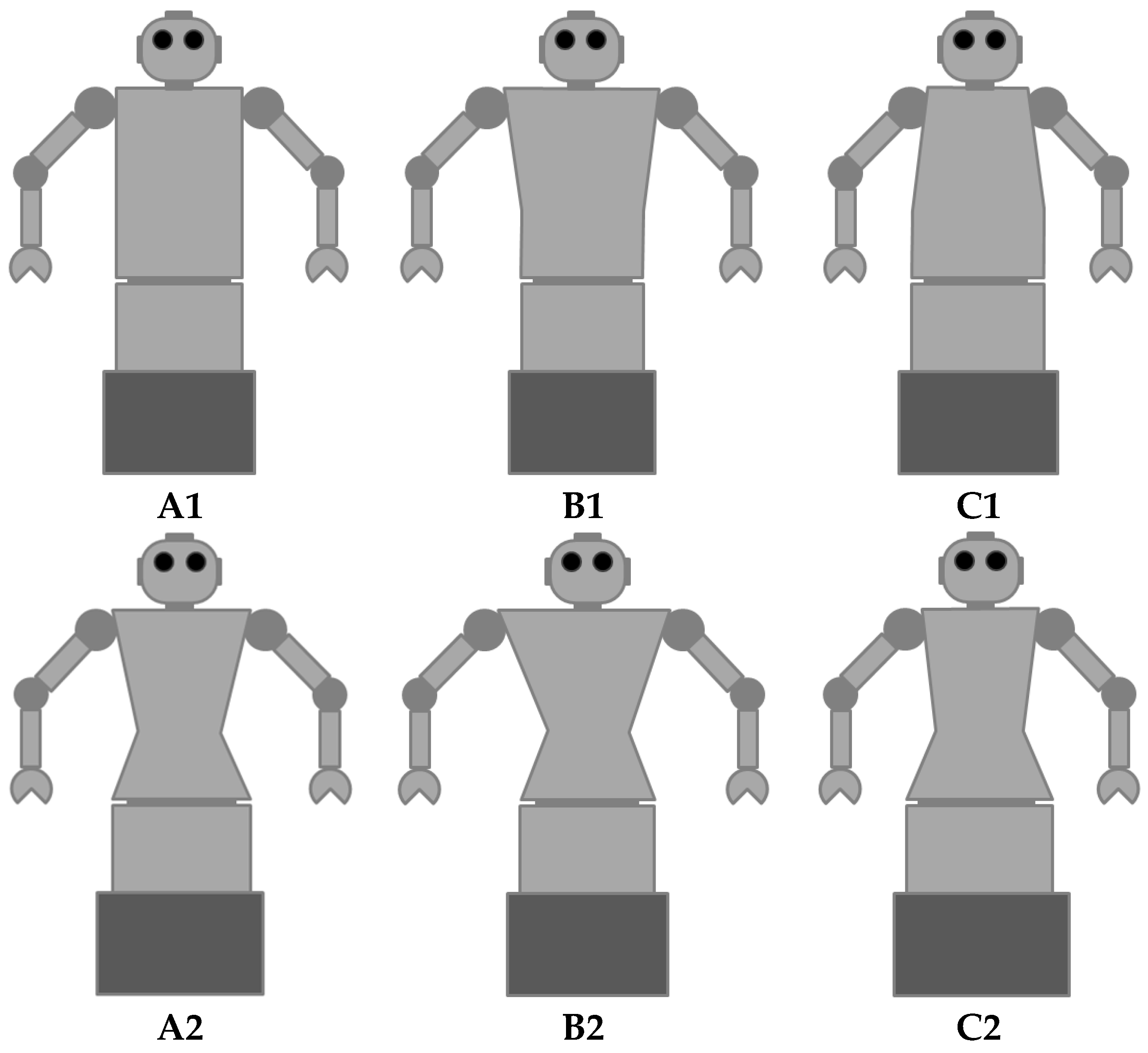
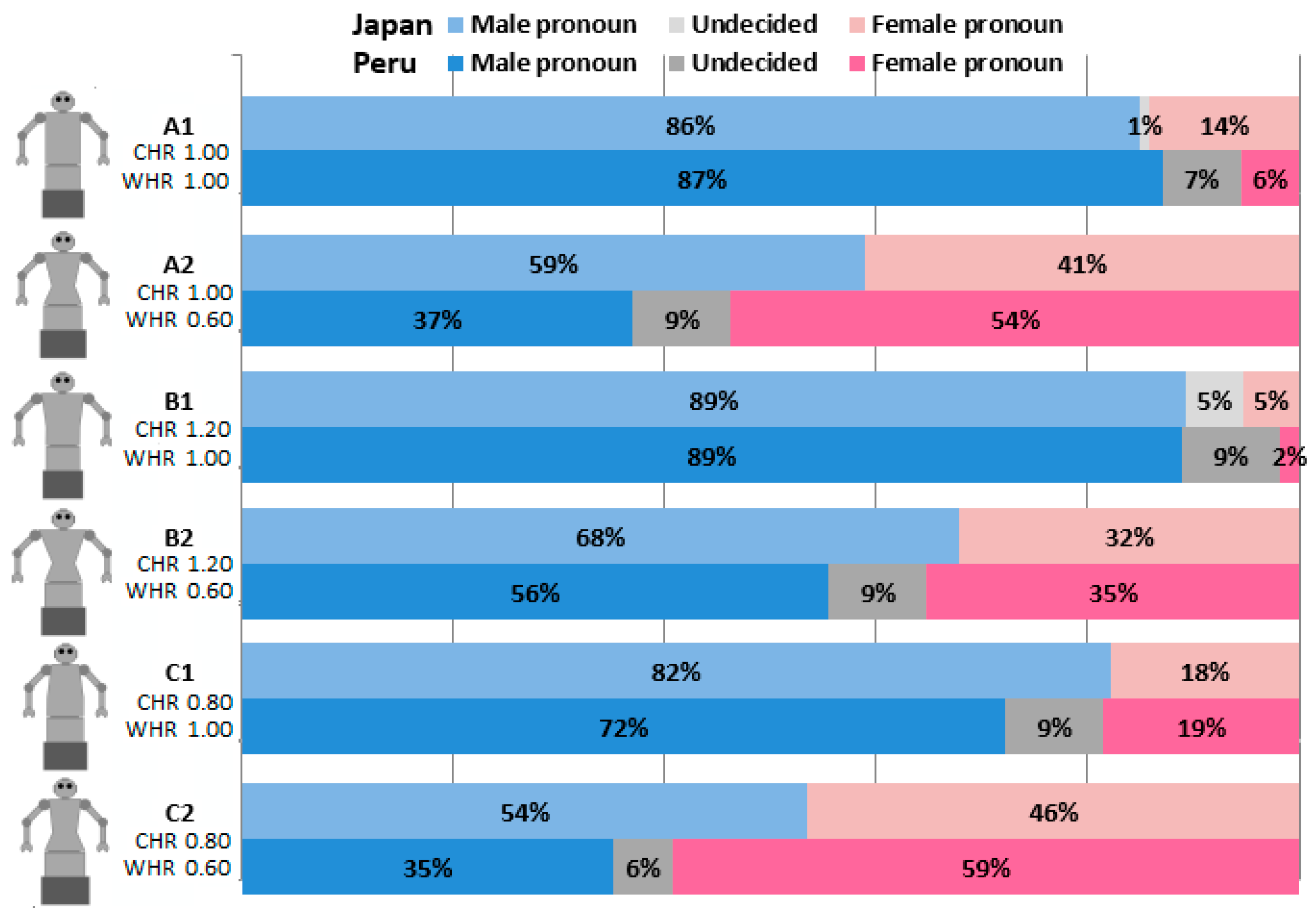
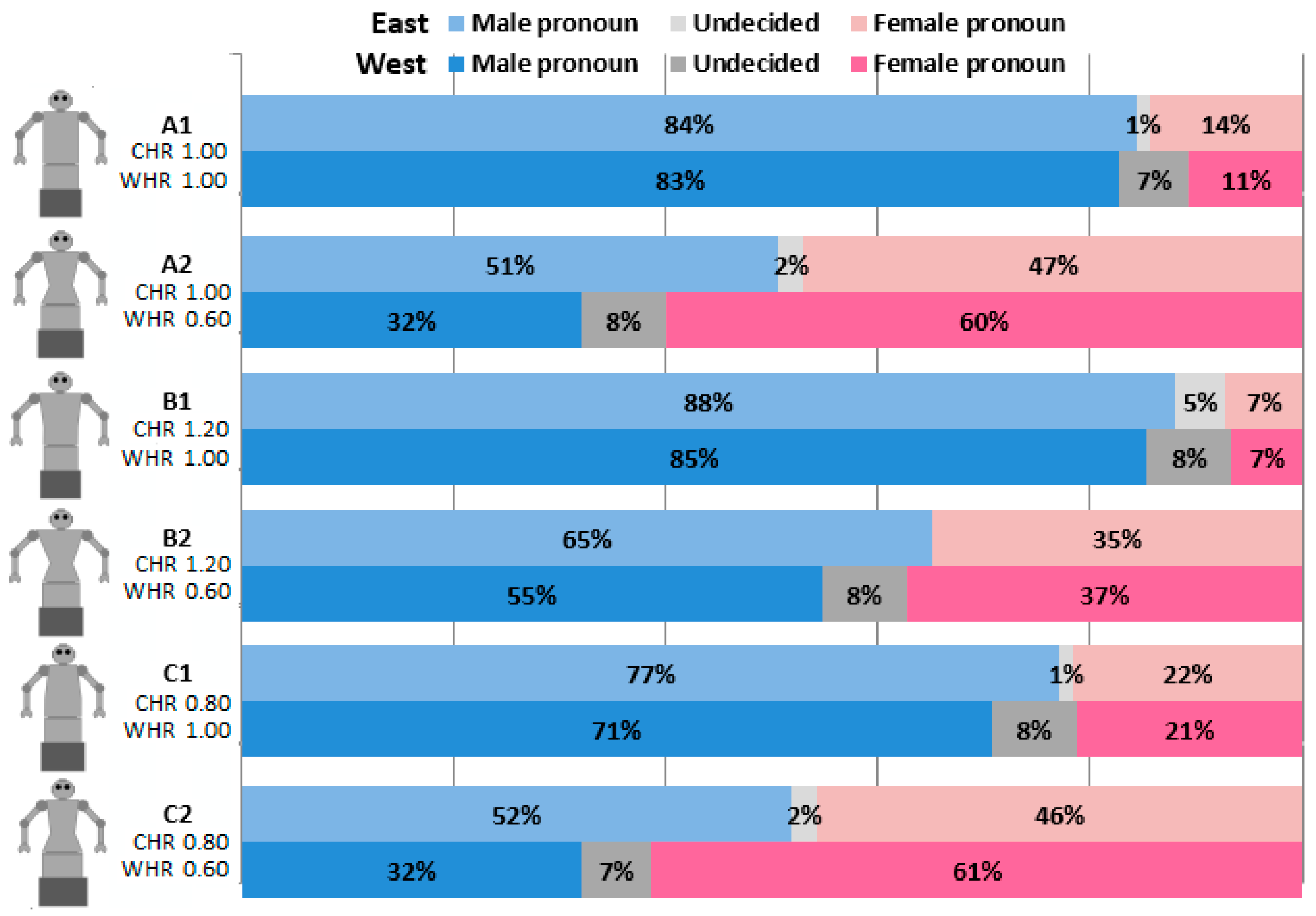
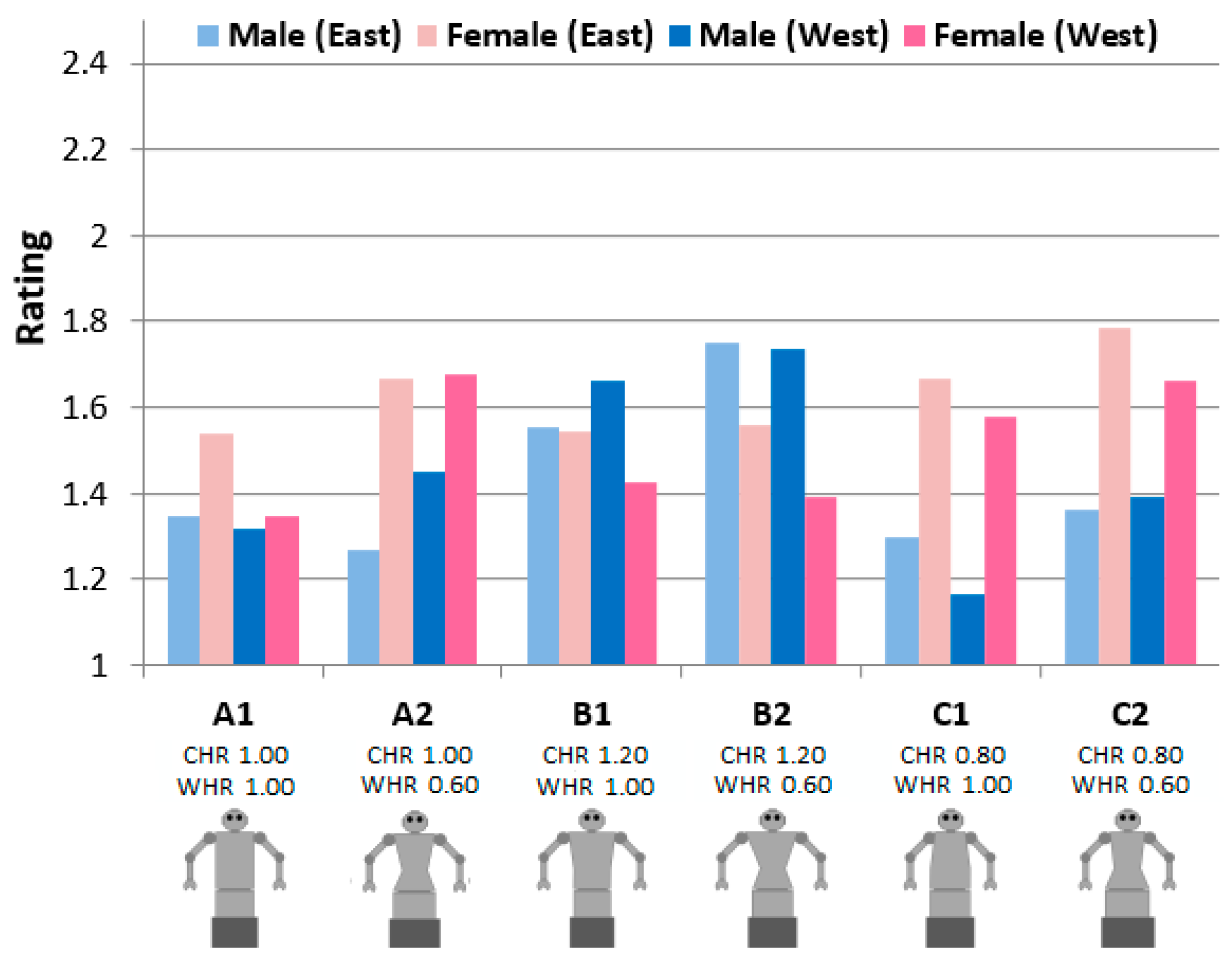
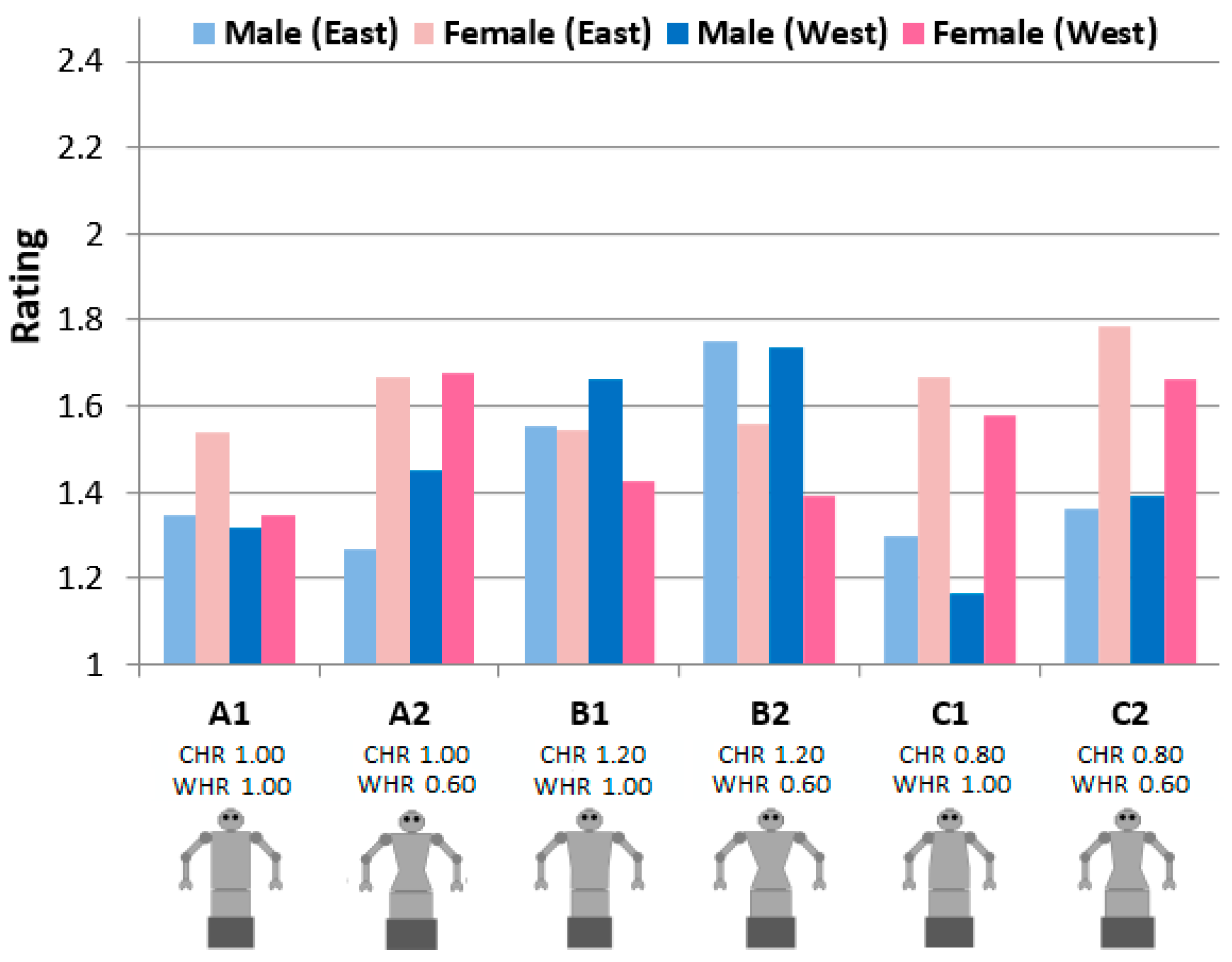
| English Attribute | Spanish Attribute | Japanese Attribute |
|---|---|---|
| affectionate | cariñoso/a | 愛情深い |
| sensitive to others’ needs | sensible a las necesidades de los otros | 気が利く |
| dominant | dominante | 支配的な |
| aggressive | agresivo/a | 攻撃的な |
| warm | cálido/a | 温かい |
| tender | tierno/a | 繊細な |
| forceful | fuerte | 力強い |
| loves children | amante de los niños | 子ども好きな |
| strong personality | personalidad fuerte | 強靭な心をもつ |
| acts as a leader | actua como líder | 統率力のある |
© 2018 by the authors. Licensee MDPI, Basel, Switzerland. This article is an open access article distributed under the terms and conditions of the Creative Commons Attribution (CC BY) license (http://creativecommons.org/licenses/by/4.0/).
Share and Cite
Trovato, G.; Lucho, C.; Paredes, R. She’s Electric—The Influence of Body Proportions on Perceived Gender of Robots across Cultures. Robotics 2018, 7, 50. https://doi.org/10.3390/robotics7030050
Trovato G, Lucho C, Paredes R. She’s Electric—The Influence of Body Proportions on Perceived Gender of Robots across Cultures. Robotics. 2018; 7(3):50. https://doi.org/10.3390/robotics7030050
Chicago/Turabian StyleTrovato, Gabriele, Cesar Lucho, and Renato Paredes. 2018. "She’s Electric—The Influence of Body Proportions on Perceived Gender of Robots across Cultures" Robotics 7, no. 3: 50. https://doi.org/10.3390/robotics7030050
APA StyleTrovato, G., Lucho, C., & Paredes, R. (2018). She’s Electric—The Influence of Body Proportions on Perceived Gender of Robots across Cultures. Robotics, 7(3), 50. https://doi.org/10.3390/robotics7030050





